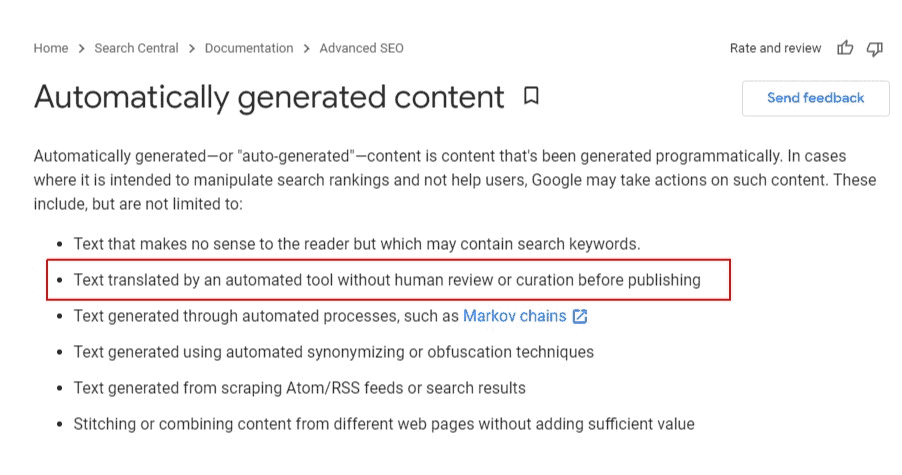One of the key challenges of going global with an e-commerce business is translating your website into different languages.
And this is a demanding task!
You must choose the right technology, check if your translation team is qualified for the job, review the translation to ensure it looks good, and do many other tasks.
Having a list of the important steps for this project can help you do it efficiently.
This is what I’ll do in this article.
These are 6 steps I recommend to our clients before translating their e-commerce website.
You can click the links below to quickly access the section you want.
Step 1: Think About Localization, not Translation
Creating a multilingual copy of an e-commerce store goes beyond a standard translation process. Visitors to your multilingual e-commerce website will come from different cultures and countries. You need to connect and build a relationship with them via the words, images, and other elements on your website.
This connection can be built with localization, not translation.
Localization makes the website look like it was created and designed to serve the customers of a certain country or language.
This can be achieved through things like using images that reflect the culture of your customers, showing the prices in the local currency, translating product names as used inside the countries you are targeting, and setting up the layout of the website according to the layout standards of the language you are translating into.
You can even go further with localization and see what functional aspects you need to change.
For example, asking for a zip code in a contact form is a known practice in the US market, but not in Germany. So, a zip code box may confuse the German customers of the website, and this may mean fewer conversions.
So, think localization, not translation, when you create a multilingual copy of the website.
I will use both terms interchangeably for the rest of the article. But remember, localization of an eCommerce website converts more visitors than just translation.
Step 2: Plan the Content Sections You Need to Translate
Having a plan for the translation content will make everyone happy. You, the translators, and your web development team.
Start by having a list of the products you need to translate. The list shall include the products you can sell to the target country, from a cultural and legal perspective. For example, sexual toys are sensitive products in the Arabic market, so you may need to exclude these from your translation because they are not culturally fit.
Maybe you need to have approvals for certain products before selling them online in certain countries. Check for these approvals as well.
Apart from the products, there are some other parts of the website you need to translate too.
Think about the touchpoints you have with your customers during and after they buy your products. The emails your customers receive after they buy the products need to be translated. Such as order details, order confirmation, and promotional emails, you may send later on.
The legal pages are another important section of the website that needs translation. Pages like terms and conditions, privacy policy, refund policies, cookie tracking, and other pages that explain the legal terms.
Other parts may include blog articles, customer reviews, tutorials, and the content that you think may help your customers decide to buy your products.
the advantages of having a multilingual website
Step 3: Consider SEO Localization to Attract Organic Traffic
A French or a German version of an e-commerce store is a stand-alone website. It will require a dedicated strategy to attract organic traffic from search engines, such as Google, Bing, Yandex, or Baidu.
There is a lot you can do to improve the Search Engine Optimization (SEO) of your multilingual website during the translation process.
Before you start, prepare a list of keywords that are important to generate the right traffic to the different versions of your website. These can be the categories of your products or even the names of your top products, only as a start.
Ask your translators to translate these keywords accurately based on the search volume. The translation can be correct, but it does not use the same keywords used by your customers when they search for your products online.
For example, the keyword “Hearing Aids” can be translated as “معينات سمعية” (which counts for 20 monthly searches in Egypt) or “سماعات طبية للأذن” (which counts for 320 monthly searches in Egypt)
Which one should be used for the translation of “hearing aids”? Of course, the one with the highest search volume.
Also, you will need to translate your meta descriptions and meta titles in a way that attracts more clicks. Ask your translators to provide creative translations for your meta descriptions and titles, not literal ones.
Step 4: Choose A Translation Software That Makes Your Life Easy
There are a ton of translation apps, plugins, and tools in the market to choose from.
But you need one that supports your languages, integrates with your CMS, and streamlines the translation process.
Most languages are read through two layouts, right-to-left or left-to-right. For example, French is a left-to-right language, while Arabic is a right-to-left language. The direction applies to the layout of the website of that language as well. So, menus in Arabic should be to the right, and paragraph formatting should be the same.
If you choose software that does not support your languages, you will need to do a lot of work to tweak the look of the translated website. Which is not a nice thing to do.
Also, the translation software should integrate with your Content Management System (CMS) to help you manage the translation process. If you built the e-commerce website using Shopify, make sure the translation app is compatible with it.
Another question you need to ask is can you export the website content outside the software? And what are the available export formats? Exporting the content will help you assign the translation phase and speed it up. Also, the more export formats, the better.
Step 5: Stay Away from Automated Translation.
You create a multilingual e-commerce website to sell more of your products to international customers.
When they come to your website, the sentences and words they read should make sense to them. The writings used on the website should be creative and connect with your customers.
How are your headlines written? How are your products described? What words are used in your paid advertisements? All this helps you communicate with your customers.
This type of communication can not be built with automated translations! Yes, machine translation tools such as Google Translate, witnessed huge developments in the last few years, but still need human intervention to make them better.
Also, Google makes it clear in their guidelines, an automated translation that is not reviewed by a human translator may lead to websites being penalized.

You are jeopardizing the reputation of your e-commerce website if you depend only on automated translation, and may get penalized by Google as well.
Step 6: Hire a Specialized Translation Agency for the Project
As you see, there are many pieces of the puzzle when it comes to translating your e-commerce website. You need to work with a translation agency that understands how to manage all these pieces and connect them.
So, look for an agency that understands the correct workflow of a website translation process, especially an e-commerce one.
You can vet the translation company by asking a few questions. Who do they hire to work on these projects? Do they work with an in-house team? Or a freelance one? What languages do they support? What are the tools they can work with?
Ask about the qualifications of their translators. Are they native speakers? Did they receive the right training? Do they have a good educational background?
What about their previous or current customers? Did they work with similar clients? What types of content did they translate before?
Asking all these questions can give you an idea of whether they can be a good fit for your e-commerce website translation.
Conclusion
The challenges of translating e-commerce websites can be less if you follow the best practices.
Always think about how to localize the website, not to translate it. Choose a translation app or plugin to streamline the translation phase and make the website look right in the eyes of your customers.
Choose a reliable translation partner for this project. Vet them through questions, and review their qualifications.
If you combine SEO with website translation, you will have a huge win over your competitors.

